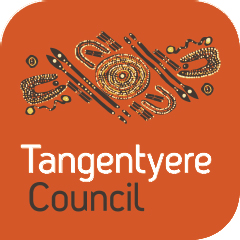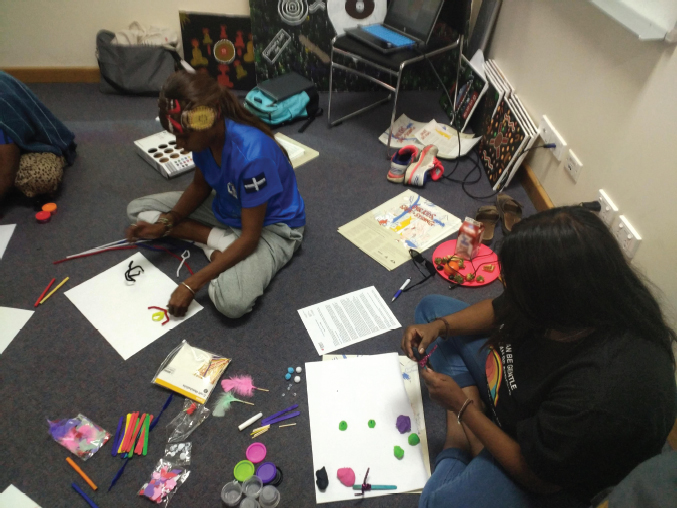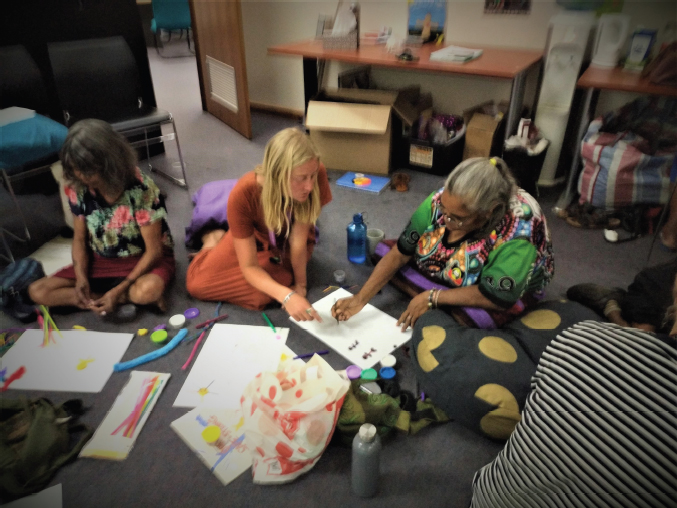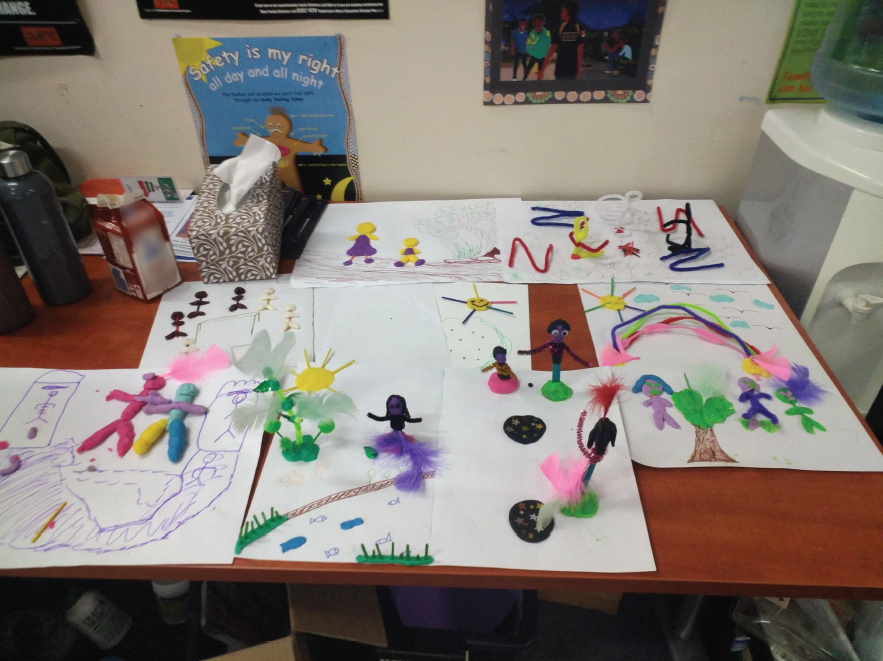10. Tangentyere Council
Carmel Simpson, Maree Corbo and Chay Brown

Tangentyere Council began operating in the early 1970s and was established to assist Aboriginal people to gain some form of legal tenure of the land they were living on in order to obtain essential services and housing. The resistance evident in the political history and struggle of Tangentyere Council speaks of resilience and determination. Through a long-term fight with local, Territory and national governments there are now sixteen Town Camps on special purpose leases. There are approximately 1600-2000 town camp residents, plus many visitors from remote communities. The overall population increases during football tournaments and other special events. Each Town Camp comprises a largely distinct Indigenous community based on language and kinship groups. Other Town Camps have residents belonging to other language groups, whose traditional lands are further out of Alice Springs, but who have moved to Alice Springs over a period for various reasons. Town Camps residents often have strong links with remote communities and there is substantial mobility between bush and town Tangentyere Council Aboriginal Corporation is a community-controlled grass-roots not for profit organisation delivering human services and social enterprise activities for the benefit of Aboriginal people from Central Australia. Tangentyere Council has 16 Town Camp corporate members, over 600 individual members and provides services to in excess of 10,000 people from a region that covers approximately 873,894 square kilometres. Tangentyere Council was originally a Community Housing Organisation and while housing continues to be major source of advocacy, Tangentyere has now expanded to include a broad range of Human Services including the following: 1) Child safety; 2) Aged and Disability; 3) Youth; 4) Employment and Training; 5) Family services; 6) Alcohol and Other Drugs; 7) Community Safety; 8) Secretariat Support; 9) Chronic Diseases; 10) Family Violence Prevention; and 11) Social Enterprise Development (Foster et al, 2005).
Tangentyere Council has had a partnership with RMIT University social work since 2015. This partnership has been built predominantly on social work student placements but has included multiple collaborations including training, research projects, publications and consultations. Between 2015 and 2021 the Tangentyere Family Violence Preventions Program have hosted over 40 social work students to undertake their placements at Tangentyere Council. Students have had placements opportunities across multiple programs including organising forums, developing short videos, planning community events and marches, planning advocacy trips to Canberra, writing grant and funding applications, developing resources, contributing to the support of the Leaders of the Tangentyere Women’s Family Safety Group and building strong and lasting relationships.
The Tangentyere Family Violence Prevention Program (TFVPP) where most students undertake their placements, began in 2014 and comprises four programs: Tangentyere Women’s Family Safety Group (TWFSG) (Primary Prevention and Early Intervention); Tangentyere Domestic Violence Specialist Children’s Service (Early Intervention/ Response); Tangentyere Men’s Behaviour Change Program (Response), Men’s Outreach Assessment and Referral Service (Response) and the Strong Families Program (Early intervention and Primary Prevention). The Tangentyere Family Violence Prevention Program (TFVPP) acknowledges the high-risk nature of Family Violence in Town Camp communities and at the same time recognises the range of additional contributing factors that impact on men’s use of violence, such as physical and mental health issues, homelessness, housing overcrowding, alcohol and drug issues, education and employment issues plus socio economic and historic disadvantage often contributing to serious harm in their relationships. The program acknowledges that these factors adversely impact on the relationships that men have with their partners, children and in their community and as a result the TFVPP’s response to Family violence is holistic recognising the additional intersectional barriers and oppression many of the families we work for experience (Brown, 2019).
Tangentyere Placement Model
The TFVPP group describe our placement model as “two-way learning”. The leaders of the TWFSG describe the intersection of two-way learning between workers and communities as: Two-way learning is Aboriginal and non-Aboriginal people coming together to build a safe and strong community through working together. The principle of “two-way learning” is the equal sharing of skills and knowledge between our students and community members by developing future social workers who can genuinely participate, listen and learn from Aboriginal community while at the same time our students share their skills and knowledge with Town Campers (Brown, 2020).
In the Northern Territory, ‘two-way learning’ as a concept has been used synonymously with bilingual education (Muller, 2012), but the idea has since expanded and come to mean a collaboration between different worldviews. ‘Two-way learning’ is the idea that Indigenous peoples must be recognised as having their own knowledge, systems, and worldviews already in place and are not ‘blank slates’ when they enter the classroom or workplace (Fleer, 2002). Indigenous people’s knowledge is being increasingly recognised as a strength and asset to Indigenous learners, workers, and leaders (Fleer, 2002). Historically, Indigenous and mainstream knowledges were considered almost diametrically opposed – whilst Indigenous knowledge emphasises the transference of knowledge through experience, immersion, and storytelling in a relational and holistic worldview, mainstream knowledges emphasise separation, ‘facts’, testing, and objectivity (Muller, 2012; Loppie, 2007; Barnhardt & Kawagley, 2005)
Increasingly, however, ‘two-way learning’ has come to be conceptualised as a collaboration between Indigenous and mainstream or Western knowledges, which when used in tandem can yield its own unique insights (Muller, 2012). ‘Two-way learning’ means that both knowledge bases sit alongside each other and are used symbiotically, one is not placed above the other (Barnhardt & Kawagley, 2005). One of the best ways to conceptualise ‘two-way learning’ – which has been used by Batchelor Institute among other education institutions and ecological programs – is the Yolngu Ganma metaphor (Bat, Kilgariff , & Doe, 2014). Ganma means a place where salt water and fresh water meet and mix – in this place, the streams serve to strengthen each other and there is a unique biodiversity that exists in these places that does not exist elsewhere (Muller, 2012). In the same way, when Indigenous knowledges and mainstream knowledge are used in equitable collaboration, they strengthen one another and create a meaningful exchange (Muller, 2012). In this is stark contrast to the history of exclusion or dismissal of Indigenous ways of knowing, being, and doing (Barnhardt & Kawagley, 2005). ‘Two-way learning’ therefore seems to redress historical power imbalances and create a culture of meaningful collaboration where everyone can learn and everyone can teach (Fleer, 2002).
In 2019 Tangentyere Council and RMIT University undertook a collaborative ‘Two-way learning’ research project. It sought to examine the extent to which non-Indigenous social work students benefit from ‘two-way learning’ during their placement at TFVPP. In this way, the key beneficiaries of ‘two-way learning’ are people coming from a largely Western or mainstream knowledge base and culture. The research project sought to conceptualise ‘two-way learning’ from a Central Australian perspective and examined how it manifested in the learning experiences of RMIT social work students. The findings from this project are currently being published for wider distribution (Brown, 2020). The research identified that students are overwhelmingly positive about their learning experiences at TFVPP, and they report that they gained a lot from their student placements. Although the context is challenging and confronting, students are well prepared to be open to the diverse nature of the placement and to be as flexible as possible. Students felt that their expectations were exceeded, and they did not expect to be given so much responsibility and varied opportunities whilst on placement with TFVPP. The TFVPP benefit from the practical support students provide, as well as the project work created by the students and the students benefit from the experience and context of TFVPP. The two parties each have a knowledge base to share: The Leaders of the TWFSG have lived experience, knowledge, culture and context to share, the staff in the TFVPP have practice based experience, theories and frameworks to underpin the work and practical application while the students’ have recent academic theories and frameworks to share that keeps the work of the TFVPP current. Participants in this research project understand that ‘two-way learning’ is the ongoing sharing of culture, story, experience, and knowledge in a balanced and open way that leads to the forging of a strengthened relationship. This exchange requires both parties to be trusting and respectful, and willing to balance the power between them. Participants know that ‘two-way learning’ benefits both parties, and there is a strength produced from this symbiosis that has the potential to provide unique and creative solutions. All parties benefit from the relationships and connections that are formed and strengthened through student placements, which have shown to become an asset that can be drawn upon in the future, in both professional and personal capacities.

Image 16 Tangentyere Council Art Workshop © Tangentyere Council.
This image is used with the permission of Tangentyere Council, the photographer, Chay Brown and the people in the photo. It is not to be reproduced without permission. For more information, go to https://www.tangentyere.org.au/.

Image 17 Tangentyere Council Art Workshop © Tangentyere Council.
This image is used with the permission of Tangentyere Council, the photographer, Chay Brown and the people in the photo. It is not to be reproduced without permission. For more information, go to https://www.tangentyere.org.au/.
 Image 18 Tangentyere Council Art Workshop © Tangentyere Council.
Image 18 Tangentyere Council Art Workshop © Tangentyere Council.
This image is used with the permission of Tangentyere Council, the photographer, Chay Brown and the people in the photo. It is not to be reproduced without permission. For more information, go to https://www.tangentyere.org.au/.
Impact of Covid-19
Since 2015, 2020 was the first year Tangentyere Council did not host RMIT social work students, due to the global Covid-19 pandemic. For the Tangentyere Family Violence Prevention Program, the absence of students was a disappointing but necessary result of border closures and action to keep some of the most health vulnerable members of the Northern Territory community safe. At the time of writing, the Northern Territory is one of the few territories in the world to see limited community transmission or Covid-19 deaths.
2020 also highlighted the vulnerability and systemic under resourcing that many Aboriginal Community Controlled Organisations (ACCO’s) have been emphasising for many years. Systemic issues such as a shortage of housing, under resourcing of health services and food insecurity coupled with border closures all led to a very concerning time for the Northern Territory in 2020 and 2021.
In March 2020, under the advice of Aboriginal Land Councils, ACCOs and Aboriginal Health Organisations, the Northern Territory Government, through the Commonwealth Biosecurity Act 2015, established bio-security zones for anyone entering the NT and for anyone wanting to travel to any of the remote Aboriginal Communities of the Northern Territory. These bio-security zones lasted for 3 months until June 2020. For the majority of 2020 and 2021 there were also restrictions for NT residents on interstate travel and quarantine requirements upon return. These restrictions have been a public health measure designed to keep some of Australia’s most heath vulnerable people isolated from infection of Covid-19 until vaccines became available.
Tangentyere Council staff have worked to support Aboriginal communities and people of the Northern Territory in a myriad of ways, including transport to return people to Country, provide emergency relief for people experiencing domestic violence which saw an increase during Covid-19 lockdowns.
Student Placements
The partnership between Tangentyere Council and RMIT social work is underpinned by ‘two-way learning’. Students can participate in diverse activities and programs including immersion in the community and multiple learning experiences including direct practice as well as group programs and contribute to a wide range of projects.
The following provides an overview of some of the projects that students have assisted in supporting:
Short videos:
- Stories of Hope and Healing (Tangentyere Family Violence Prevention Program 2017a).
- Mums Can Dads Can Italk (Tangentyere Family Violence Prevention Program 2019).
- Music Videos through youth work camps (Tangentyere Family Violence Prevention Program 2017b).
Planning community events, marches and advocacy trips to support the visibility of Aboriginal Women Leaders from the Town Camps:
- 2017 The Tangentyere Women’s Family Safety Group hold the largest March against Domestic and Family Violence that Central Australia has ever seen (Brennan 2017).
- 2018 Tangentyere Women’s Family Safety Group go to Canberra to ask the Federal Government to “Listen to Us, Stand with Us, Support Us” (Thorpe 2018).
- 2019 The Tangentyere Women’s Family Safety Group plans and delivers NAIDOC Week and Reclaim the Night Events for Mparntwe, Alice Springs.
Girls Can Boys Can Project
Since 2019 students have been involved in the Mums Can Dads Can and Girls Can Boys Can Project These two programs/ campaigns aim to promote gender equality in families and young children by looking at the rigid gender stereotypes of females and males (Tangentyere Family Violence Prevention Program, 2020). These campaigns aim to shift community attitudes around gender roles through advocating that people can be free from gender stereotypes. For students, being able to be involved in the implementation stage of a campaign enabled us to appreciate how much work goes into making a successful campaign and promote a message. There were several things that need work in order to promote a successful gender equality campaign. Secure funding, long term resources, a holistic approach that involves the whole community, as well as media saturation and public engagement are all needed for a successful program that aims to prevent family violence. The TFVPP have had students involved in all stages of design, development, consultation, implementation and evaluation for these project and campaigns and have shared a mutually beneficial process of two-way learning.
Conclusion
‘Two-way learning’ is embedded into TFVPP, and as such, students who undertake placements there come to have a developed understanding of ‘two-way learning’ and place great importance on it as a principle, value, and transferrable skill that continues to benefit them once they return home. Student placements at TFVPP are directly and explicitly guided and shaped by a ‘two-way learning’ process, that sees students meaningfully gain from and contribute to the program’s work. Covid-19 has been a particularly challenging time for the program, but the program adapted and continued. Covid-19 highlights the importance of two-way learning and showed the leadership of Aboriginal communities, who lead advocacy to get border closures in place. The principles of two-way learning and self-determination have never been more important.

